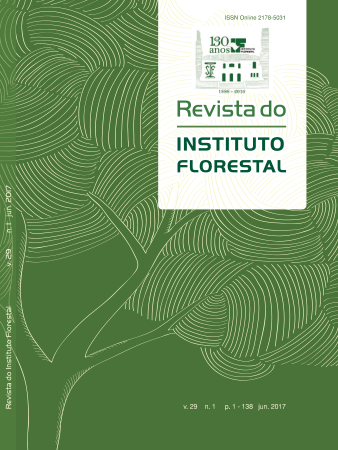GROWTH AND SURVIVAL OF FOUR SPECIES OF Eucalyptus spp. AT CANOINHAS – SC
DOI:
https://doi.org/10.24278/2178-5031.201729107Keywords:
eucalypt, periodic annual increment, mean annual increment, height, DBH, volumeAbstract
The present work aimed to analize the growth and survival rate of an experimental forest plantation with four species of the generaEucalyptus, E. dunnii, E. benthamii, E. cloesiana and E. saligna, in the city of Canoinhas – SC. The forest area contains 10 lines with 25 trees each, at a spacing of 3 m x 3 m with an area of 2,250 m2 and five years old. The forest census was carried out with measuring tape for diameter measurement and hypsometer for height measurement.Measurements were made in 2012, 2013, 2014, 2015 and 2016. The survival rate, the Mean Annual Increment – MAI and the Periodic Annual Increment – PAI over the years were calculated. The diameter distribution and mean height for each species were also evaluated. The best MAIs were E. benthamii, E. dunnii and E. saligna, respectively 46.21, 42.87 and 40.77 m3.ha-1.year-1. The species with the worst performance was E. cloesiana with 12.24 m3.ha-1.year-1. The species E. benthamii, E. dunnii and E. saligna reached the technical cutting age. The survival rates were 96% for E. dunniii, 94% for E. saligna, 82% for E. benthamii and 80% for E. cloesiana. The results suggest that the E. cloesiana species is less adapted to the climate of the study site, with a lower survival rate and lower growth.
Downloads
References
BERGER, R. et al. Efeito do espaçamento e da adubação no crescimento de um clone de Eucalyptus saligna Smith. Ciência Florestal, v. 12, n. 2, p. 75-87, 2002.
CAMPOS, J.C.C.; LEITE, H.G. Mensuração florestal: perguntas e respostas. Viçosa-MG: UFV, 2013. 605 p.
CLIMATE-DATA. Clima: CANOINHAS. Disponível em: <http://pt.climate-data.org/location/43657/>.Acesso em: 2 jan. 2016.
DALLABRIDA, V.R. Indicação geográfica edesenvolvimento territorial: reflexões sobre o tema e potencialidades no Estado de Santa Catarina. São Paulo: Liber Ars, 2015. 296 p.
DIAS, A.N. et al. Emprego de um modelo de crescimento e produção em povoamentos desbastados de eucalipto. Revista Árvore, v. 29, n. 5, p. 731-739, 2005.
EMPRESA BRASILEIRA DE PESQUISA AGROPECUÁRIA – EMBRAPA. Árvore do conhecimento: Eucalipto. Disponível em: <http://www.agencia.cnptia.embrapa.br/gestor/eucalipto/arvore/CONT000h018teyx02wx7ha07d3364ani5o3a.html>. Acesso em: 4 jan. 2016.
FERREIRA, C.A.; TIMONI, J.L. Contribuição ao estudo da época de corte em povoamentos de Eucalyptus spp. Silvicultura, v. 14, p. 85-86, 1980.
INDÚSTRIA BRASILEIRA DE ÁRVORES – IBÁ. Relatório anual 2016. Brasília, DF, 2016. 100 p.
INSTITUTO DE PESQUISA E ESTUDOS FLORESTAIS – IPEF. Indicações para a escolha de espécies de Eucalyptus. Disponível em: <http://www.ipef.br/identificacao/eucalyptus/indicacoes.asp>. Acesso em: 2 jan. 2017.
STURGES, H.A. The choice of a class interval. Journal of the American Statistical Association, v. 21, n. 153, p. 65-66, 1926.
KÖPPEN, W.; GEIGER, R. Klimate der Erde. Gotha: Verlag Justus Perthes, 1928.
OLIVEIRA, J.T.S. et al. Caracterização de madeira de sete espécies de eucaliptos para a construção civil: 1 – avaliações dendrométricas das árvores. Scientia Forestalis, n. 56, p. 113-124, 1999.
REZENDE, J.L.P.; OLIVEIRA, A.D. Análise econômica e social de projetos florestais. Viçosa-MG: UFV, 2013. 383 p.
SANQUETTA, C.R. et al. Inventário florestal: planejamento e execução. Curitiba: Mult-Graf, 2014. 409 p.
















